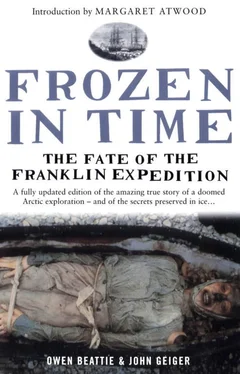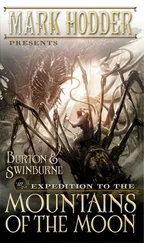Before leaving the Arctic, Schwatka met an old Inuk woman and her son who told a grim story of finding relics of the Franklin expedition on the shores of the North American mainland many years before, including one of the lifeboats the retreating crewmen had been dragging. Schwatka recorded the son’s account:
Outside the boat he saw a number of skulls. He forgot how many, but said there were more than four. He also saw bones from legs and arms that appeared to have been sawed off. Inside the boat was a box filled with bones; the box was about the same size as… one with the books in it.
The last thirty or forty of Franklin’s men had apparently left the tragedy of King William Island behind them near the mouth of the Peffer River and crossed Simpson Strait, only to exhaust their last hopes in the barren reaches of an area Schwatka named Starvation Cove. (It has been argued that the two boxes may have contained the remains of Sir John Franklin and the expedition logs, but they have been lost forever.) A search of the area revealed little, only the partial remains of one sailor. The Inuit explained that the land had reclaimed the rest of the bodies—that the bones had sunk into the sand, mute testimony of the horror that visited the area so long ago.
Schwatka’s party returned to the United States in September 1880. The Illustrated London News provided detailed coverage of the expedition’s journey across King William Island, including an explanation for the absence of proper graves:
The coast had evidently been frequently visited by natives, who had disinterred those who had been buried for the sake of plunder, and left their remains to the ravages of the wild beasts… [Schwatka’s party] buried the bones of all those unfortunates remaining above ground and erected monuments to their memory. Their research has established the fact that the records of Franklin’s expedition are lost beyond recovery.
The president of the Royal Geographical Society concluded that the Franklin search expeditions had succeeded in surveying much of the Arctic archipelago and “expunged the blot of obscurity which would otherwise have hung over and disfigured the history of this enlightened age.” Despite the failure to locate the ships’ records, or either of the two vessels, the Franklin searches had also pierced the Arctic long enough to answer the fundamental mysteries of the expedition’s disappearance. Its route had been generally established, the reason for the desertion of the Erebus and Terror was made known and the Inuit accounts and sad discovery of relics on King William Island attested to the crews’ final chilling days of life.
With the great search at last over, Tennyson wrote the epitaph for the Westminster Abbey memorial to Franklin:
Not here: the white North hath thy bones, and thou
Heroic Sailor Soul
Art passing on thy happier voyage now
Toward no earthly pole
Britain transferred sovereignty of the Arctic islands to Canada in 1880. The Northwest Passage was finally sailed by Norway’s Roald Amundsen in 1903–06, aboard a wooden sloop named Gjoa. It was perhaps fitting that Amundsen should have been the first, for it was the narrative of Franklin’s 1819 overland journey that led him to dream of being a polar explorer. “Oddly enough it was the sufferings that Sir John and his men had to go through which attracted me most in his narrative. A strange urge made me wish that I too would go through the same thing,” wrote Amundsen, who conquered the passage and later the South Pole, only to die in a plane crash in Arctic waters in 1928. Royal Canadian Mounted Police Sergeant Henry Asbjorn Larsen later sailed the passage from west to east aboard the St. Roch in 1940–42, and from east to west in 1944.
Occasionally, bones thought to belong to a Franklin expedition member were discovered. In one case, a partial skeleton was sent to Canada’s National Museum in Ottawa, where it remains in storage. And in 1923, the explorer Knud Rasmussen, a native of Greenland, reported interring some remains on the east coast of the Adelaide Peninsula, which, from surviving scraps of clothing and footwear, were “unquestionably the last mortal remains of Franklin’s men.”
Rasmussen also wrote down Inuit oral history of the discovery of a deserted ship, found when the natives were hunting seals off the northwest coast of King William Island. One old man named Qaqortingneq described what was seen by those who went aboard: “At first they were afraid to go down into the lower part of the ship, but after a while they grew bolder, and ventured also into the houses underneath. Here they found many dead men, lying in the sleeping places there; all dead.”
Major L.T. Burwash of Canada’s Department of the Interior made several visits to King William Island, interviewing Inuit elders for further clues about the Franklin expedition. In April 1929 he secured a statement from two men named Enukshakak and Nowya who told of finding, forty years earlier, a large cache of wooden cases carrying “tin containers, some of which were painted red.” According to the men’s account, some of these provisions were tins of preserved meat, purportedly found on a low flat island to the east of King William Island. They expressed their belief that the cache was left by the crew of a ship that had been wrecked off nearby Matty Island. This testimony, coupled with the report, recorded by Schwatka, of a wreck a short distance from O’Reilly Island, prompted Burwash to present the theory that some of Franklin’s crews had returned to the Erebus and Terror and that “the ships were eventually brought to their final resting places while more or less under the control of their crews.”
Burwash also included with his account what was purported to be unpublished testimony from a member of Charles Francis Hall’s expedition, by then deceased, which strangely never made it into Hall’s official account. Attributed to an Inuk hunter, this additional material revealed that Sir John Franklin may have been buried in a cement vault on King William Island: “one man died on the ships and was brought ashore and buried… in an opening in the rock, and his body covered over with something that ‘after a while was all same stone.’”At the time the remains were interred, “many guns were fired.”
In 1930, Burwash and pilot W.E. Gilbert would become the first men to fly to Grozier’s Landing. However, there was little more than some rope and broadcloth left for them to see. Gilbert described the scene in an article published in the Edmonton Journal on 9 September 1930:
Bitter winds across the still snow-covered ground made work difficult and the ravages of the tremendous storms encountered here had largely obliterated the remains of the camps in the eighty years which had elapsed.
There was no sustained challenge to Franklin’s reputation mounted in Victorian times. It was not until 1939 that Canadian Arctic explorer Vilhjalmur Stefansson wrote his essay, “The Lost Franklin Expedition,” and asked how these sea-toughened men, armed with shotguns and muskets, could have “contrived to die to the last man” of hunger so quickly in a land where the Inuit had survived for generations, hunting with Stone Age weapons.
Stefansson concluded that the chief failure of the Franklin expedition, and other nineteenth-century British explorers of the Arctic, was in the refusal to respond to the harsh environment by adopting the ways of the Inuit: “The main cause… was cultural.” An explorer and ethnographer, and a man who had subsisted on a fresh meat-only diet in the Arctic for seven years, Stefansson repeatedly argued that the Arctic explorers would have thrived had they done the same. As he wrote: “The strongest antiscorbutic qualities reside in certain fresh foods and diminish or disappear with storage by any of the common methods of preservation—canning, pickling, drying, etc.” Yet as late as 1928, Stefansson’s theories about the antiscorbutic value of fresh meat continued to be greeted with skepticism. As a result, he submitted to a bizarre experiment in which he ate nothing but raw meat for a year while living in New York City. To the astonishment of medical observers, he remained perfectly healthy.
Читать дальше










